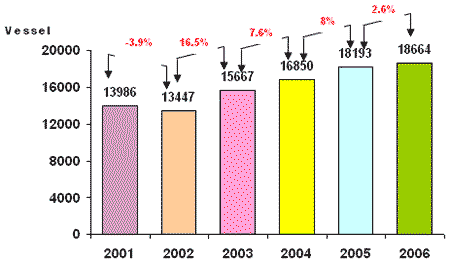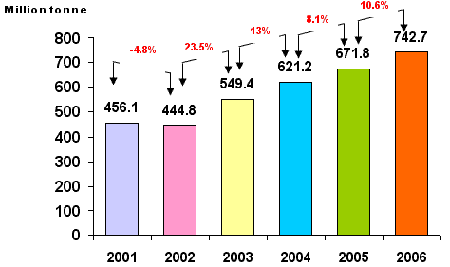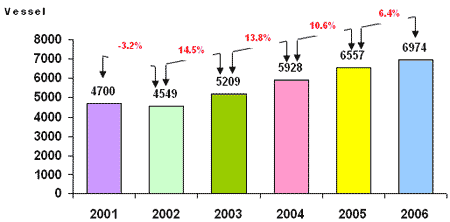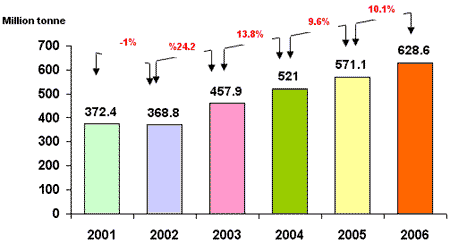 to Seabird
Marine Services, Suez ship chandler and Suez Canal transit agent. to Seabird
Marine Services, Suez ship chandler and Suez Canal transit agent.
Seabird Marine Services was established in the year of 1981 at Port of
Suez as Ship chandler, General ship supplier
and Suez Canal transit ship agent, serving vessels calling Suez, Egyptian
Ports or transiting Suez Canal.
From the beginning we were known for, honesty and reliability which built
our high reputation and expanded
client's network world wide and created high growth situation.
Today Seabird Marine Services has branches in every Egyptian port with
dedicated professional team and a large warehouse in a tax free area,
gathering most of the items requested by vessels calling Egypt. This
enables us to fulfill the
balance of the equation" high quality @ reasonable prices @ the right
time".
|
Continuous growth and advanced management
allowed SeaBird Marine Services to become one of
the market leaders In Suez Canal area and
all Egyptian Ports in both fields of Ship chandler &
Suez Canal Transit agency
"Seabird Marine Services" today is one stop services station
Where you can have peace of mind and obtain all these services in
one contact:
* General Ship Supply
* Life rafts & Safety Equipment supply and services with
class
certification
* All repair works with qualified certified technicians
* All Spare Parts supplies
* Underwater works (Inspection, Repair & Cleaning)
* Spare Parts parcels custom clearance &
Delivery on board
* Shipping Agency & Suez Canal Transit Services
Suez
Canal
SeaBird-Marine is on the spot in the
Suez Canal as the reliable intermediary for transit co-ordination,
funds transfer and efficient communication. With local offices in
Port Said and Suez Port, SeaBird-Marine is positioned to ensure a
smooth and prompt transit.
Egypt : Profile
- Most yachts visit Egypt only to transit the Suez Canal and
very few visit the country itself.
- The only area of the country worth cruising is in the Red Sea,
the reefs and bays stretching from the Sudanese border to the Gulf
of Suez. Day sailing along this coast is the most pleasant way to
make progress against the prevailing northerlies.
- Safaga or Hurgada, on the Red Sea, are both places where the
boat can be left to visit the interior; although at neither should
the boat be left unattended.
- In recent years the Red Sea coast has seen a rapid growth in
tourist resorts and developments including several new marinas
such as the Abu Tig and Port Ghalib Marinas, which form part of
large resorts.
- In the Mediterranean, Alexandria is the only alternative to
Port Said.
- Occasionally yachts manage to obtain a permit to sail up the
River Nile, a fascinating but not easy way to see Egypt
- Terrorist attacks by Islamic fundamentalists against foreign
visitors have badly affected tourism, and while this situation
continues, the internal situation should be monitored carefully.
Very hot summers; mild winters with little rain. The prevailing
winds in the Red Sea are northerly, while along the Mediterranean
coast there are daily alternating land and sea breezes. Occasionally
the khamsin, a hot dry wind, blows off the land laden with dust and
sand reducing visibility.
Port Said : Shore Services
Provisioning is somewhat better in Port Said, which is a
duty-free port and stores can be ordered and delivered to the yacht
club. There is a daily fresh produce market.
Company Profile
SeaBird was established as Navigation & Communication Systems
private limited Company in Egypt in 1981.
Our quality targets aim at providing our customers with high quality
service in a quick, efficient, and accurate manner and clear
communication with our customers and efficient follow-up on
projects, in order to facilitate their timely completion.
Our company provides system integration and related services to the
following market sectors:
Aids to navigation
Vessel management and surveillance.
Remote site monitoring.
Shipboard electronic navigational equipment.
Automatic vehicle location and dispatch.
High speed voice and data communications.
GSM network installation
Our design is due to the most updated international standardizations
using highly qualified designer engineers to ensure the best design
possible for customer satisfaction.
SeaBird will use only the best available navigation and
communication equipment from selected suppliers and good maintenance
techniques. We maintain appropriate testing of our service, during
the installation and maintenance processes until the end of each
process.
SeaBird guarantees warranty of the project that has been supplied
and installed by the company to ensure customer satisfaction.
Project quality is facilitated by a quality system, consistent with
ISO-9001: 1994, which results amongst other things, in personnel
having the required experience in appropriate administrative
procedures.
The quality of our service is of the utmost importance to the
continuity of our business. Consequently we expect all our employees
to contribute to maintain and if possible to improve, our quality
levels
Services
"We provide our clients with technology solutions and services
which exceed their expectations"
Two strategic areas of professional services.
Distinct, complementary, and in line with the direction of the
marketplace
Services offered:
Systems Integration
Long Term Support and Maintenance Services
Project Management
Major Activities:
Project Management
Systems Engineering
Equipment Specifications
Equipment Procurement
Documentation
Translation
Installation
Testing
Training
Customer and Warranty Support
Life Cycle Management and Maintenance.
New announcement…
We would like to inform you about our
New services as following :
1- Charge and discharge of all dry bulk (corn, wheat,
soya bean, sugar, fertilizers, etc......)
2- Bagging of all kinds of dry bulk using our mobile bagging machines.
3- Charging and discharging clinker and cement
using our equipment.
4- Transportation using our trucks.
5- we have 100,000 sq meters in Dekhela port,
suitable for warehousing general cargo and
containers (We will be ready for RoRo containers
in about 3 month time as we do not have any
container fork lift or reach stacker yet).
Providing our Customers with
Suez Canal Transit List

|
-
-
-
Subscribe to our NewsLetters
View online or right click and select "Save target
as..." to download the file.
Download Our Suez Canal Transit Guide
Advice to Shipmasters
Southbound Transits
Northbound Transits
Download Rules Of Navigation in Suez Canal (PDF)
Specialized Ports
Egypt has passed law no 1 for 1996 concerning Specialized ports followed
by the minister of transport resolution no 81 for 1999 relating to lagging
down an executive regulation for specialized ports law Specialized ports
mean these establishments on the Egyptian coasts or in the Egyptian EEZ
built for the purpose of receiving. Fishing vessels, oil tarkers, minerals
or tourist yachts. Specialized ports also refer to these ports of a
specific nature, or specialized maritime platforms and berths inside the
general ports
ln addition to 16 berths and scaffolds under the supervision of the
central depart ent for Specialized ports ( under construction)
The Number of Specialized Ports ( 45 ) as follows
14 Petroleum Ports - 9 Mining Ports - 11 Toristic Ports - 8 Fishing Ports
- 3 Scaffold
Petroleum Ports
Mining Ports
Toristic Ports
Fishing Ports
Port Map
Gabal El Zeit
El Zeit East
El Hamra(El Allamin)
Mersa Badran
Edco For Liquefied Gas
Ras Shukheir
Sidi Kerir(Sumid)
Wadi Feiran(Abu Redeis-El Nazazat)
Ras Sidr
Sadat
Ain Sukhna(Sumid)
Ras Gharib
El Maadiya(Petroget)
El Zaytyat
Port Map
Abu Zenimah
Bernees
Abu Ghosoun
Al Qusayr
Hamrawein
Safaga Mining Port(El Masriyeen)
Safaga Mining Port(Abu Tartour)
El Rasif El Bahari(Ras Hagariya)
Rasif El Sharkiyoun(Mackdirmout)
Port Map
Hurghada
Taba Heights
Port Ghalib
Port Map
Project Overview
Port Description
Navigational Characterestics
Port's Services and Facilities
Fees
Owning Company
Dome Valley Marina
El Gonah
Marina Port(El Alamein)
San Stefano
Port Said Tourist Port
Mersa Alam
Abu Suma
Sahl Hashish
Port Map
Attaka Fishing Port
Port Said Fishing Port
El Maadiya Fishing Port
(El Maadiya Strait)
EL Tour
New EL Brols
Mersa Matrouh
Arish port
Abu Kir Fishing Port
Scaffold
Shark Bay Scaffold
Trafco Marina
Neama Bay Scaffold
|
|
|
|
About The Suez Canal


The Suez Canal
( Arabic: Qanat as-Suways ),is an artificial sea-level waterway
running north-south across the Isthmus of Suez in Egypt to connect the
Mediterranean and the Red seas. The canal separates the African
continent from Asia, and it provides the shortest maritime route between
Europe and the lands lying around the Indian and western Pacific oceans.
It is one of the world's most heavily used shipping lanes.
The Suez Canal is one of
the most important waterways in the world.
The canal is extensively used by modern ships, as it is the
fastest crossing from the Atlantic Ocean to the Indian Ocean . Tolls
paid by the vessels represent an important source of income for the
Egyptian government.
Railroad and a sweet water canal are run on the west bank parallel
to the Suez Canal .
The Canal runs between Port Said harbor and the Gulf of Suez ,
through soils which vary according to the region. At Port Said and the
surrounding area, the soil is composed over thousands of years of silt
and clay sedimentations deposited by the Nile waters drifted by Damietta
branch. This formation extends to Kantara, 40 km to the south of Port
Said , where silt mixes with sand. The central region of the Canal
between Kantara and Kabret consists of fine and coarse sands, while the
southern region contains dispersed layers of rocks, varying in texture
from soft sand to some calcium rocks.
The Suez Canal is a sea level Canal and the height of water
level differs slightly and the tide is 50 cm high in the north and 2 m
high in the south. The banks of the Canal are protected against the wash
and waves, generated by the transit of ships, by revetments of hard
stones and steel piles corresponding to the nature of soil in every
area. On both sides of the Canal, there are mooring bollards every 125 m
for the mooring of vessel in case of emergency, and kilometric sign
posts helping locate the position of ships in the waterway. The
navigable channel is bordered by light and reflecting buoys as
navigational aids to night traffic.
The side gradient of the water cross section differs according to the
nature of the soil, which is 4:1 in the north and 3:1 in the south.
Most of the canal is limited to a single lane of traffic, but
4 bypasses ( total length 78 Km ) are located
along the Canal, and this allows the transit of ships in both
directions. :
| 1. Port Said by-pass |
36.5 km accomplished in 1980 |
| 2. Ballah by-pass |
9.0 km accomplished in 1955 |
| 3. Timsah by-pass |
5.0 km accomplished in 1980 |
| 4. Deversoir by-pass and the Bitter Lakes area |
27.5 km accomplished in 1890 |
Importance & Advantage of SC
The Suez Canal is
considered to be the shortest link between the east and the west due
to its unique geographic location; it is an important international
navigation canal linking between the Mediterranean sea at Port said
and the red sea at Suez . The unique geographical position of the
Suez Canal makes it of special importance to the world and to Egypt
as well.

This importance is getting augmented with the evolution of maritime
transport and world trade. The maritime transport is the cheapest
means of transport, whereas more than 80 % of the world trade volume
is transported via waterways (seaborne trade).

Saving in distance, time and in operating costs for vessels that
transit the Canal, also firm up this importance.
Saving in distance via SC
The geographical
position of the Suez Canal makes it the shortest route between East
and West as compared with the Cape of Good Hope. The Canal route
achieves saving in distance between the ports north and south of the
Canal, the matter that is translated into other saving in time, fuel
consumption and ship operating costs as shown in the table below :
About 10 % of the world seaborne trade passed
through the Suez Canal in 2014.
|
SC |
Cape |
Miles |
% |
| Ras Tanura |
Constanza |
4 144 |
12 094 |
7 950 |
66 |
| Lavera |
4 684 |
10 783 |
6 099 |
57 |
| Rotterdam |
6 436 |
11 169 |
4 733 |
42 |
| New York |
8 281 |
11 794 |
3 513 |
30 |
| Jeddah |
Piraeus |
1 320 |
11 207 |
9 887 |
88 |
| Rotterdam |
6 337 |
10 743 |
4 406 |
41 |
| Tokyo |
Rotterdam |
11 192 |
14 507 |
3 315 |
23 |
| Singapore |
Rotterdam |
8 288 |
11 755 |
3 647 |
29 |
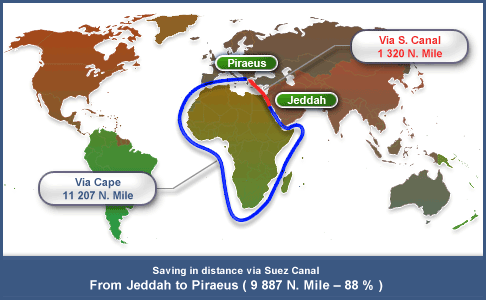
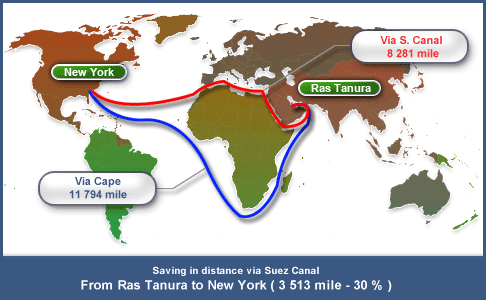
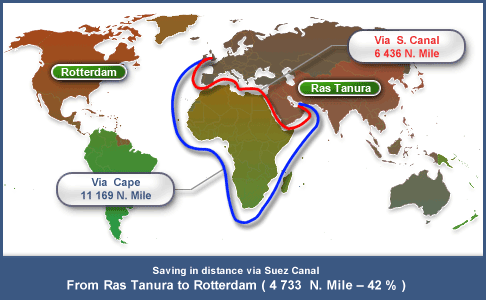
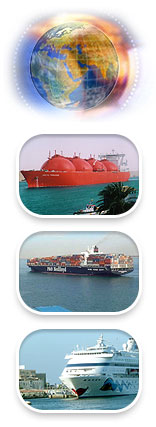 |
Vision & Mission
Suez Canal Mission
- To ascertain that the vital role of the Suez Canal in
service of the world economy and trade is established.
- To manage and run the Suez Canal in a way that maximizes its
capabilities and position.
- To upgrade c performance of the Suez Canal to cope with the
requirements and challenges of the present and future time as
well as the international changes.
Suez Canal objectives
- To draw up plans for the Suez Canal .
- To develop and promote the navigable channel.
- To secure safety, security and relevant services for the
transiting vessels.
Suez Canal Duties
- To draw up and execute plans that secure optimized transits
for vessels.
- To develop and maintain the Canal to be able to handle the
evolution of the world trade and the growth of the World Fleet.
- To provide the transiting vessels with services, towage and
repairs.
- To build ships and different marine units at the SCA’s
shipyards.
- To draw up plans and policies for the companies affiliated
to the SCA.
|
Canal Nature
The Canal runs
between Port Said harbor and the Gulf of Suez , through soils
which vary according to the region. At Port Said and the
surrounding area, the soil is composed over thousands of years
of silt and clay sedimentations deposited by the Nile waters
drifted by Damietta branch. This formation extends to Kantara,
40 km to the south of Port Said , where silt mixes with sand.
The central region of the Canal between Kantara and Kabret
consists of fine and coarse sands, while the southern region
contains dispersed layers of rocks, varying in texture from soft
sand to some calcium rocks.

The Suez Canal is a sea level Canal and the height of water
level differs slightly and the tide is 50 cm high in the north
and 2 m high in the south. The banks of the Canal are protected
against the wash and waves, generated by the transit of ships,
by revetments of hard stones and steel piles corresponding to
the nature of soil in every area. On both sides of the Canal,
there are mooring bollards every 125 m for the mooring of vessel
in case of emergency, and kilometric sign posts helping locate
the position of ships in the waterway. The navigable channel is
bordered by light and reflecting buoys as navigational aids to
night traffic.

The side gradient of the water cross section differs according
to the nature of the soil, which is 4:1 in the north and 3:1 in
the south.
The Suez Canal has been doubled in four
parts (78 Km.), and this allows the transit of ships in both
directions. :
| 1. Port Said by-pass |
36.5 km accomplished in 1980
|
| 2. Ballah by-pass |
9.0 km accomplished in 1955 |
| 3. Timsah by-pass |
5.0 km accomplished in 1980 |
| 4. Deversoir by-pass and the Bitter Lakes area |
27.5 km accomplished in 1890 |
CHARACTERISTICS OF THE SUEZ CANAL :
|
Overall
Length |
Km |
164 |
175 |
175 |
190.25 |
190.25 |
190.25 |
190.25 |
| Doubled Parts
|
Km |
-- |
29 |
29 |
78 |
78 |
78 |
78 |
|
Width at 11
m depth |
m |
44 |
60 |
90 |
160 |
180/210 |
180/210 |
200/210 |
| Water depth
|
m |
10 |
14 |
15.5 |
19.5 |
20.5 |
21 |
22.5 |
|
Max. Draft
of ship |
Feet |
22 |
35 |
38 |
53 |
56 |
58 |
62 |
| Cross Sectional Area
|
m2 |
304 |
1100 |
1800 |
3600 |
3800/4300 |
3900/4500 |
4800 |
|
Max. Loaded
ship |
DWT |
5000 |
30000 |
80000 |
150000 |
180000 |
185000 |
220000 |
INFLUENCE OF THE SUEZ CANAL ON WORLD TRADE :
The geographical position of the Suez Canal makes it the
shortest route between East and West as compared with the Cape
of Good Hope. The Canal route achieves saving in distance
between the ports north and south of the Canal, the matter that
is translated into other saving in time, fuel consumption and
ship operating costs as shown in the table below : About 8.5% of
the world seaborne trade passed through the Suez Canal in 2006.
|
Historical outline |
| The Suez Canal is considered to be the shortest
link between the east and the west due to its unique geographic
location; it is an important international navigation canal
linking between the Mediterranean sea at Port said and the red
sea at Suez. The idea of linking the Mediterranean sea with the
red sea by a canal dates back to 40 centuries as it was pointed
out through history starting by the pharaohs era passing by the
Islamic era until it was dredged reaching its current condition
today. |
 |
| It is considered to be the first
artificial canal to be used in Travel and Trade. The Whole Idea
of establishing a canal linking between the red sea and the
Mediterranean dates back to the oldest times, as Egypt dredged
the firs artificial canal on the planet’s surface. The pharaohs
dredged a canal link in between river Nile and the red sea. This
canal ran a while and then stopped until Muslims conquered Egypt
under the leader ship of Amr-Ebn-El-Aas complying with the
orders of Omar Ebn El Khattab. When the Portuguese discovered
Ras El Raga El Saleh at the beginning of the 16th century the
world trade movement changed making Egypt and Alexandria not
considered the heart of it anymore. |
| After that it was Francis Delicips the one with
the idea of re-dredging the Canal in (25 April, 1859) and was
formally opened during the ruling of El Khedive Ismael (17
November, 1869) in a major celebration which was attended by
most of Europe’s kings and Princes and the license period was 99
years from the date of opening of the canal and then it becomes
after that a property of the Egyptian Government, and the French
owned most of its stock. |

|
| After July 1952 Revolution, president Gamal Abd
El Naser publicized the canal in announcement in (26 July, 1956)
making the management of the canal a 100% Egyptian, which
enraged the major countries leading to the Triad assault on
Egypt in (29 October, 1956) which caused to the closing of the
canal and it was reopened in (march 1957) and after that it was
closed again ( 1976) due to the ships laying in the bottom of
the canal and was not reopened again until (June 1975). |

|
|
Stages of developing the Suez Canal |

|
The dredging of the canal took almost 10 years
using Egyptian labor, and it was opened for navigation for the
first time in 17 November, 1869. Its depth was about 8 meters,
its water are was 304 m2 and the largest ship load that can pass
through was 5000 tons, which was typical for ships sizes in
these days. As the ships developed and increased its sizes, the
canal needed to be developed, which happened when it was still a
foreign joint venture before being publicized to take ships with
depth of 35 feet and its water area to be 1100 m2 by the end of
1956 and when the canal was publicized by the Egyptian
government on the 26th of July, 1956. The Egyptian
administration was keen to develop the |
|
Navigation canal even more on different stages |
| In May 1962, the water area of the canal was
to reach 1800 m2 and the allowed depth to 38 feet. In June
1966, a development was to be executed on 2 stages as it was
announced the depth would reach 48 and 58 feet consecutively.
This program was started in February 1962, but was soon halted
due to the war that erupted on the 5th of June, 1967. It was
reopened for international; navigation in June 1975 after
purifying it from the ships that sank in its bottom during in
the 1962 and 1973 wars with the same water area and depth
before it was closed. The development projects then started by
the Egyptian administration in order to receive ships of a
210,000 tons load, specially after increasing the water are to
4800 m2 and a depth of 62 feet , with a length of 190.25 km,
in addition to the redesign of the canal's turns so that each
one has a half radius of at least 5000 m and also dredging a
new verge starting from the 17th km south of port said heading
directly to the Mediterranean east of port Fouad to allow the
loaded ships going north to go to the sea without passing
through port said port. The Suez canal is distinguished by its
stable level of water which varies very slightly having the
highs tide reaching 50 cm in the north while reaching up to 2
m in the south. |
| Vice Admiral/Ahmed Fadel has assured head of the Suez
Canal port authority, the depth will reach 66 feet by 2006
pointing out that this stage will enable all container
vessels; about 17,000 container vessels; as well as taking all
bulk vessels world wide. His Excellency also pointed that the
Canal will be able to take in about 99 % of all methods used
in world maritime transport after reaching a depth of 72 feet
in 2012, as well as taking about 99% of he dead weight tons
for the bulk vessels 82% of the petroleum tanks and a 100% of
all the remaining types of ships used in maritime transport;
specially container vessels with all its future generations;
in addition to empty vessels reaching up to 560 thousand tons.
|
 |
Current state for year 2006 - 2005 - 2006
The position of the Suez Canal for year 2006
Total number of vessels calling at Suez Canal 18664 ship
Net Tonnage 742.7 million Ton
Container Vessels 6974 ship
Net Tonnage of Container Vessels 366549 Thousand Ton
Cargo volume from North to South 252215 Thousand Ton
Cargo volume from South to North 376420 Thousand Ton
Total cargo volume 628.6 million Ton
Containerized cargo from North to South 126082 Thousand Ton
Containerized cargo from South to North 150817 Thousand Ton
Total of Containerized cargo 276899 Thousand Ton
The position of the Suez Canal for year 2005
Total number of vessels calling at Suez Canal 18193 ship
Net Tonnage 671782 Thousand Ton
Container Vessels 6557 ship
Net Tonnage of Container Vessels 321302 Thousand Ton
Cargo volume from North to South 244836 Thousand Ton
Cargo volume from South to North 326269 Thousand Ton
Total cargo volume 571105 Thousand Ton
Containerized cargo from North to South 119006 Thousand Ton
Containerized cargo from South to North 128130 Thousand Ton
Total of Containerized cargo 247136 Thousand Ton
The position of the Suez Canal for year 2004
Total number of vessels calling at Suez Canal 16850 ship
Net Tonnage 621230 Thousand Ton
Container Vessels 5928 ship
Net Tonnage of Container Vessels 284307 Thousand Ton
Cargo volume from North to South 211563 Thousand Ton
Cargo volume from South to North 309427 Thousand Ton
Total cargo volume 520990 Thousand Ton
Containerized cargo from North to South 108341 Thousand Ton
Containerized cargo from South to North 112038 Thousand Ton
Total of Containerized cargo 220379 Thousand Ton
Number of passing containers (approximately) More than 15 Million
TEU
Totals of Suez Canal
| |
2001 |
1981 |
2003 |
2004 |
2005 |
2006 |
| Total Crossing Vessels (Vessel)
|
13986 |
13447 |
15667 |
16850 |
18193 |
18664 |
| |
-3.9% |
16.5% |
7.6% |
8.0% |
2.6% |
| Net Tonnage (million tons) |
456.1 |
444.8 |
549.4 |
621.2 |
671.8 |
742.7 |
| Number of Containers (Vesel) |
4700 |
4549 |
5209 |
5928 |
6557 |
6974 |
| Total Cargo Volume (million tons) |
372.4 |
368.8 |
457.9 |
521 |
571.1 |
628.6 |
| |
-1.0% |
24.2% |
13.8% |
9.6% |
10.1 |
Traffic of Vessels Crossing Suez Canal
Net Tonnage of Vessels Crossing Suez
Canal
Number of Containers Crossing Suez
Canal
Total Cargo Crossing Suez Canal
Traffic System
The Canal is run in a convoy system allowing
ships to transit as fixed speed and a fixed separation distance
between every two passing ships, Three convoy pass through the Canal
every day, two southbound against one northbound. Each of the three
convoys follows a certain system as for the time of entering the
Canal, the speed limits and the emergency stopping distance between
every two ships within the one convoy.
The Suez Canal has been doubled in four
parts (78 Km.), and this allows the transit of ships in both
directions:
- Port Said by-pass 36.5 km. accomplished in 1980
- Ballah by-pass 9 km. accomplished in 1955
- Timsah by-pass 5 km. accomplished in 1980
- Deversoir by-pass 27.5 km. accomplished in 1980
It is worth mentioning that the more doubled
parts the Canal has, the less transit time ships shall have and the
more their number will be.
The Suez Canal pilots are credited with
piloting ships from the time they arrive at the roadsteads till they
exit at the other end of the Canal to the open sea.
It takes the ship from 12 to 16 hours to
transit the Canal. The numerical capacity of the Canal is about 76
standard ships per day.
Characteristics
| Overall Length |
Km. |
164 |
175 |
175 |
190.25 |
190.25 |
190.25 |
190.25 |
| Doubled Parts |
Km. |
- |
29 |
29 |
78 |
78 |
78 |
78 |
| Width at 11 m. depth
|
m. |
44 |
60 |
90 |
160 |
180/210 |
180/210 |
200/210 |
| Water depth |
m. |
10 |
14 |
15.5 |
19.5 |
20.5 |
21 |
22.5 |
| Max. Draft of Ship
|
Feet |
22 |
35 |
38 |
53 |
56 |
58 |
62 |
| Cross Sectional Area
|
m2 |
304 |
1100 |
1800 |
3600 |
3800/4300 |
3900/4500 |
4800 |
| Max. Tonnage (DWT)
|
Ton |
5000 |
30.000 |
80.000 |
150.000 |
180.000 |
185.000 |
210.000 |
Influence of the Suez Canal on World
Trade
The geographical position of the Suez Canal
makes it the shortest route between East and West as compared with
the Cape of Good Hope. The Canal route achieves a saving in distance
between the ports north and south the Canal, the matter that is
translated into other savings in time, fuel consumption and ship
operating costs as show in the table below
| Ras Tanura |
Constantza |
4.144 |
12.094 |
66 |
| |
Lavera |
4.684 |
10.783 |
57 |
| |
Rotterdam |
6.436 |
11.169 |
42 |
| |
New York |
8.281 |
11.794 |
30 |
| Jeddah |
Piraeus |
1.320 |
11.207 |
88 |
| Bombay |
Rotterdam |
6.337 |
10.743 |
41 |
Lighthouses (Pharos)
Egypt took for so many years ago care of
establishment of lighthouses, as a good example, we have Alexandria
Tower, one of the ancient Seven Wonders, Lighthouses are used to
facilitate the navigation in the night and day. It shortened the
length of journey to half its duration.
Aims
- Locate ports from distance
- Position vessels while navigating
- Facilitate coastal shipping
- Identify ports approaches and entrances
- Locate shoals waters and submerged islands which may endanger
safety of navigation; ex: Red Sea Islands.
Work Mechanism
Each lighthouse has its distinct sign which
could be recognized by seafarers from distance through its shape and
color by day or its flashes characteristics (range, color,
intervals) by night. It is measured in nautical miles. Lighthouses
are put on a few minutes before sunset and are off a few minutes
after sunrise and always on during mist.
Lighthouses Types
Manned Lighthouses
Has a staff of supervisors who works in
shifts. At sunset, it is lighted by electricity
Unmanned Lighthouses
Use solar energy for lighting.
Lighthouses are monitored and controlled by a main control center in
Max, Alex equipped to identify and repair their troubleshooting.
Mediterranean Sea Lighthouses
| Ras Shakik |
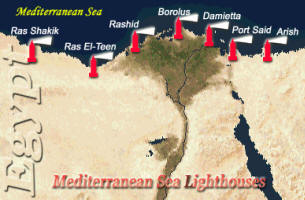 |
| Constructed in 1987, renewed in 1992 |
| Ras El Teen |
| Constructed in 1848, modified in 1919, provided
with electricity in 1954 and last modification in 1993 |
| Ras Rachid |
| Constructed in 1870 and was replaced twice, the
first in 1967 and the second in 1991 in the western bank of
Rachid branch |
| El Borolous |
| Constructed in 1870, maintained and renewed in
1932 and a new one built in 1992 |
| Damietta |
| Constructed in 1870, renewed in 1992 |
| Port Said |
| Constructed in 1886, renewed in 1902 and 1923
and a new one built in 1992 |
| El Arish
|
| Constructed in 1997 |
Red Sea Lighthouses
| Ain EL Sokhna |
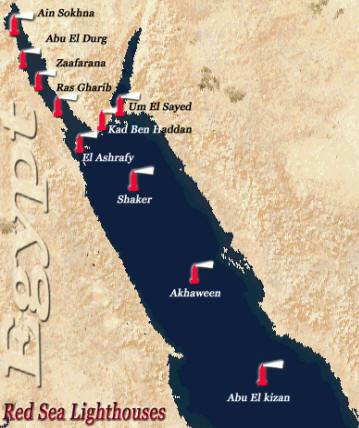
|
| Constructed in 1987 |
| Abu Darag |
| Constructed in 1926 and renewed in 1987 |
| Zafarana |
| Constructed in 1862, modified in 1930 and
renewed in 1987 |
| Ras Ghareb |
| Constructed in 1871, modified in 1928 and a new
one was built in 1987 |
| Ras Shoukir |
| Constructed in 1987 |
| Um El Sayyed |
| Constructed in 1987 |
| Kad Ben Haddan |
| Constructed in 1987 |
Remote Lighthouses
El Ashrafy
Constructed in 1862, a new one was built in 1940 and renewed in 1987
Shaker (Shedwan)
Constructed in 1889, modified in 1935, hit ten in 1967 war and
renewed in 1987
El Akhaween
Constructed in 1883, modified in 1906 and renewed in 1993
Abu El Kizan
Constructed in 1863, a new one was built in 1931 and renewed in 1993
Suez Canal Bribery

Photo Copyright © Ieuan Dolby, 2006
By Ieuan Dolby
The Captain was climbing the wall in Port Suez. He was pulling
his hair out, and every time he came out of his cabin he would
scream and bash his head against the bulkhead in frustration. The
problem was that the Customs, Officials of all shapes and sizes, the
Health Authorities and the Canal Authorities (and others), were all
wanting something and it was too much for the poor wee man.
Let me make it quite plain at this early stage of this article
that bribery is the only way to get through the Canal. I appreciate
the fact that this is not mentioned in any Canal literature or
Maritime Agency guideline but take it as true that if you dont bribe
then you will not be going through. Well, you might be going through
but only after a five day or so delay and the cost of doing so will
have tripled. Bribery is an accepted form of 'making life move
forwards' in Egypt. Every single official expects to receive gifts
and if they do not receive anything then they feel hurt and abused.
They will then make life difficult for you, most likely by following
the letter of the law which will create traumas and continuing
nightmares for the Captains involved.
Bribery is necessary to get a ship through the Canal at
reasonable cost and on the day that you want to go through.
Our Captain
Out Captain was a little Scottish miser and he had decided that
he was going to get through the Canal without greasing any palms
along the way. The rest of us on the ship tried to tell him that the
only way to get through was to "pay-the-piper" but he was decided on
his course of action. So that was why he was pulling his hair out as
every official that came onboard got upset when they received
nothing so they made life difficult for him. The Agent was one of
the worst and he spent nearly five hours trying to break down the
Captain: to make him crack. For five hours they went on and on. The
agent would request some document and the Captain would find it for
him. The Agent would then ask for six copies to be made of this
document and the Skipper would trundle on up to the bridge to make
them. Upon returning the Agent would be sitting there with his files
closed and would engage the Captain in some polite conversation
about the weather or something equally inane.
The skipper thinking that he was nearly finished with this man
was drawn into a relaxed state of mind when suddenly the agent would
pounce once again. Opening his files the agent would say, "see
Captain, now need full list of tanks, Fuel Oil, water, lubricating
Oil and need how much is in them. Terrible yes, but see Captain
here, write down in Canal Instructions. Must have Tank Capacities.
Yes Captain, you have any cigarettes, maybe bottle whisky? You have
nothing for agent Captain? Okay, we must need Tank Capacities and
need ten photocopies each document, see written here need documents
ten copies. You get now for me urgent! Maybe you have tobacco or
perfume for me?"
Now whether the official is a Customs Officer or some lowly
errand boy they are all quite blatant in their approach to gaining
bribes.
Our Skipper eventually broke down when our agent suddenly said
that he did not know what a platform supply vessel was. Captain, you
have this ship, I dont know. You must give me letter from office
saying your vessel type and name. Also say that you not have cargo.
You have maybe biscuits or coffee, I like coffee. Or you have some
Cigarettes? Why dont you have cargo on this ship? Yes, our poor
Skipper broke down and ended up giving to him (after five hours of
defiance) a bottle of perfume that he had bought to take home to his
wife. The agent was rapt with this unusual gift and upon receiving
it all of the impending paperwork that had been taken out for action
suddenly disappeared and our ship was instantly cleared for
take-off. And if our skipper had given this 'gift' right at the
beginning when the agent first appeared onboard we would have had
the clearance with little ado. Well out skipper learnt the hard way!
Cigarettes
Ships planning ongoing through the Canal normally stock up with
many cartons of Cigarettes for the pure purpose of bribery. Our
company had given to us one box of twenty cartons for this reason
and these had been delivered in Malta before we set sail for the
Canal. But our Captain was wary about giving these out as even
before we had got alongside in Port Suez three Cartons had been
given to the Pilots who wouldnt leave until they received a gift. So
at that rate he was worried that he would not have enough to get
through the Canal safely - the reason why the agent got the perfume.
In actual fact the Pilots went overboard in their desperation to
get some smokes out of us. We had arranged to pick up the pilot as
per usual at the boarding ground before proceeding in to the Port of
Suez. Not really a port that needs a Pilot but then I suppose how
are the Pilots supposed to get their cut if they don't come onto the
vessels. Anyway, we had slowed down and the Pilot Cutter drew up
beside our boarding ladder. But he would not come onboard. He
shouted up to the crew that he wanted Cigarettes before joining the
vessel and after much palaver a carton of 200 was handed down to
him. He looked at that carton as if it was 'dirt' and then looked at
the Crew and put his fingers up a basic message to state that
another carton was required before he would step foot on the vessel.
Once again our skipper was pressurized into reducing his precious
stock and eventually after this carton was handed down the Pilot
clambered up onto our vessel.
But it did not stop there. The Pilot went up to the bridge but
basically refused to take charge of the navigation of the vessel.
Our skipper increased the speed and pointed the bows towards the
Port of Suez whilst the pilot just looked out of the window with his
arms crossed and in complete silence. Meanwhile on the back deck the
crew where watching the antics of the pilot launch. This boat was
racing alongside our vessel occasionally touching our sides with the
cutter then bouncing back off in alarming fashion. The driver of the
cutter kept his finger on the horn so along with the occasional bang
we had this loud and annoying braying noise to cope with. And from
the Pilot launch figures kept on emerging (when they thought it safe
to do so) and sticking their fingers up and shouting "cigarettes,
cigarettes".
The Captain on the bridge was suffering on two scores. He felt
obliged to slow down for safety reasons as court enquiries and an
Egyptian jail did not paint a nice picture should he smash up the
pilot launch. And another reason for slowing down was that he simply
did not know which berth to dock at or where to go in the Port of
Suez seeing as how the pilot was incommunicado. Well, to cut a long
story short the skipper was forced into handing down a third carton
of smokes to the desperate bunch in the pilot cutter. He handed them
down to a now happy and smiling crew and returned to be greeted by a
happy and informative pilot, one who acted as if nothing untoward
had occurred and one who directed that ship into port with skill and
grace.
If bribes are not given the reverberations are enormous. If the
pilot does not receive his gift he will inform the next pilot (more
pilots required for the outward journey from the Port of Suez and
more still for the Canal Transit). This next pilot will then be
extremely annoying in nature like not tuning up or arriving late and
not directing the ship as he should do and this will continue down
the line. If Health officials palms are not greased problems could
be found with he vessel, if the Search Light Company does not
receive the gift the cost of fitting tow or more searchlights will
be astronomical and the Lifting Device Company will delay you ship
for a few days whilst chain blocks and lifting devices of amazing
proportions will be fitted. Of course should a carton of Cigarettes
pass their way across into the hands of the guy/official hanging
around all work lists and requirements will suddenly vanish.
As with any system or clique the size and scale of bribery in
Egypt is massive to say the least. And it is an acceptable form or
way of life especially for those running the canal. Bribery and
palm-greasing is the means for which many a family gain income and
manage to survive and without which they would starve. So whether we
in the Western World condemn this type of action or not is of no
import, we are in their country and so we should accept their
values.
The Final Straw
The last straw for our Captain was when the Search Light Company
man turned up at midnight (with us having been there since midday)
and dragged the Captain out of bed to discuss the fitting of the
searchlight forward that we were suddenly required to have for the
transit regardless of the fact that we had three searchlights of our
own and ones that were more powerful than anything they could fit.
We had all been up late tidying up the mess that the shopkeepers had
left and tying to work out if we had enough food left to get us to
the Sri-Lanka at the very least. So by midnight those of us that
could were asleep in bed, trying to get a few winks before starting
off to join the convoy at 0300hrs.
The noise coming from the corridor woke us all up. Staggering out
of bed and out of the door I became witness to a mad and scary
Scotsman with untamed hair screaming down the stairs at a visibly
frightened Egyptian man. Our Skipper had finally cracked.
The mate sorted the problem out by grappling with the Scary man
and pulling him into his cabin probably dowsed him in whisky to calm
him down. I went to see the Salesman from the Search Light Company
and between us we came to the amicable solution that one carton of
cigarettes and our last jar of strawberry jam would negate the
requirement for any more searchlights. He went away with his
trophies and I returned to bed, whishing that we were through to the
other side and on our way.
 Ship Travelling North
Ship Travelling North
Photo Copyright © Ieuan Dolby, 2006
0300hrs. I have the started the engines and the thrusters are on
the board. The crew is all on standby forward and aft for the ropes
and we have our position number in the convoy of 13.
0330hrs. The Pilot is still not here and we have missed our place
in the convoy.
0400hs. Pilot has arrived but is standing at the bottom of the
gangway and refusing to come onboard. Our Captain has decided not to
give him anything.
0415hrs. Now we are on the way, last position in the convoy but
at least we are moving. The mate decided that he didnt want to stay
another night in Port Suez so he ran downstairs and gave the Pilot
his smokes.
We are on the way. The Pilot is happy with his gift and the crew
and I are all happy to be on the way. Only the Captain remains
unhappy but it is a small price to pay for freedom.
Facts and
Figures......
of the Suez Canal

Drawing Copyright © Ieuan Dolby,
2006
By Ieuan Dolby
The Suez Canal is 193KM long. This is not your typical country
waterway with some little houseboats on it by any means! Serious
stuff belongs here! 20,000 ships pass annually through this Canal
making it the busiest Canal in the world. Okay, pretty long, pretty
deep and very wide and everything must tick like clockwork.
The governing body of the Canal is the Suez Canal Authority (SCA)
who has the ultimate say in its matters and affairs. The daily
running of the Canal is through this body and the Ministry of
Transport whose duties still remain unclear to many. The SCA is
headquartered at Ismailia on Lake Timsah (Half way along the Canal).
The Canal separates Egypt into two distinct sections: The Eastern
Bank named the Sinai Peninsular and the Western Bank which is the
main part of Egypt. The Canal itself was built to connect the
Atlantic Ocean and thus the Mediterranean to the Red Sea and thus
the Indian Ocean. The two main points at either end of the Canal are
Port Said at the North end and Port Suez at the Southern end.
The Size and Scale
It is a tough Canal to maintain with constant dredging operations
being undertaken and the SCA is forever planning larger and bigger
channels as ships around the world get bigger, faster, fatter and
deeper. Projects over the years have increased the dimensions of the
Canal so much so that in 1989 the Canal was 14 times the original
size than when the Canal was built in 1869. In 2001 a large project
got underway to deepen the Canal so that it could receive vessels of
up to 210,000 tons with a depth of nineteen meters. And now things
are getting even better and bigger with a planned development to 22
meters by 2010.
And amazingly at this depth 82% of the tanker fleet will use the
Canal and 99% of all other ships will be able to use it. In fact it
would be simpler to say that most vessels will be able to use the
Canal once the current depth has been reached. Only those tankers
classed as 'too large to see their own bow' should one be standing
at the stern have to take the long route around. The Jahr Viking
managed to get through the Canal with little problem and she weighed
in at the time with a total of 564,763 tons, so as long as a ships
draught is not greater than the depth of the Canal then there is not
much preventing most ship sailing on through.
Of course cost factors regulate why the SCA wants to deepen the
Canal. The larger the ship the more money they make. One fee paid by
one large supertanker will cover the dues paid by the other fourteen
ships in the convoy. The Canal Authority drags in well over
$2,000,000,000 US dollars per year in dues paid and this will
increase considerably once the Canal deepening project is completed.
And as an aside this 2 billion that works its way into the SCA
coffers is to pay for the transit of about 400 millions tons of
cargo on an average of 36.8 ships/day (in 2000). Again this
volumetric figure should increase disproportionately once a few more
supertankers add their large payloads onto the list.
 View of Port Suez from Canal
View of Port Suez from Canal
Photo Copyright © Ieuan Dolby, 2006
But to run a Canal is not cheap. Money has to be spent on
maintenance and on the large deepening, widening and enlargement
projects. As an example, when the Canal was deepened in to nineteen
meters in 1980 the final adding up of the project came to US$1.3
billion. Not cheap by any means and in those days well above the
income received through dues received. Another great expenditure is
the massive Radar and the System of Navigational Aids that ensure
the Safety and free flow of vessels in the Canal. The initial high
tech system that was installed cost 18 million in 1981. Since then
thousands of upgrades and modernizing features have been fitted at
great cost to the SCA.
And of course other fees have to be paid out. Least of all of
which is the constant maintenance of the banks that is nothing but
sand for most of the Canals length. And the constant dredging of the
Canals Bottom, the costs of the Tugs that are on constant standby as
vessels pass through and etc, etc, etc.
But why is it so important that ships use the Canal? Quite simply
to reduce fuel costs for those ships that worry about fuel costs and
to reduce travel time for those who worry about getting there
quickly! Apart from these two items there is no reason to use the
Canal at all but most companies want to be quick and to save on fuel
costs so.....! With the Suez Canal in operation the only people
using the longer way around by the Cape Horn are those ships too
large to fit through the Canal and those with a death wish (like
yacht people).
As an example of the usefulness of the Canal: The distance
between Jedda Port, Saudi Arabia and Konstaza in the Black Sea via
the Cape of Good Hope is 11,771 nautical miles . The Suez Canal
route reduces this distance by around 56%. The distance between
Tokyo and Rotterdam Port in the Netherlands is reduced by 23% if
made via the Suez Canal instead of the Cape of Good Hope. * The Suez
Canal transports around 7% of the world sea-borne trade, 25 % of the
trade to and from the Red Sea, and the Arabian Gulf, 20% of the
trade to and from India, and South-East Asia, as well as 29% of the
trade to and from the Far East.
The Convoys
Ships cannot just turn up at the Canal entrance, pay a man in the
glass booth and then saunter on through. There is a large system and
network of agencies and Government Bodies who control the
arrangement of the Convoys and these must be strictly adhered to
should one wish to sail through on time and with little hassle. To
book a place on a convoy arrival times of the vessel must be sent 5
days prior to the event taking place.
There are three convoys daily passing through the Canal. There
are two Convoys going Southbound (SB) and only one Convoy going
Northbound (NB). The SB convoys are at 0100 and at 0700 hrs and the
NB convoy is at 0500hrs. Vessels must arrive at a minimum of four
hours before the departure time of the Convoy.
As the typical large Tanker, Bulk carrier or Dangerous Cargo
Vessel going southbound is empty of cargo the speed maintained is
around 10knots (14km/hr). Northbound the loaded Tankers, Bulk
Carriers and the Dangerous Cargo Vessels (LPG/LNG) are required to
transit at a slower speed, usually 8-9 Knots.
Once the SCA has a ships arrival time, ships particulars and data
a place in the convoy will be issued to the Master. Faster and more
maneuverable vessels will be placed at the front of the convoy with
those more liable to breakdown, with dangerous cargoes onboard or be
unable to maintain speed will be placed at the rear. Of course
should a fine War Ship or Aircraft carrier happen to be in your
convoy they will get the number one spot - especially if it is an
American one. Many personally would prefer if they had the rear spot
but .............!
A place in the convoy, a starting time for off and a pilot is all
that is required. The Pilot Station will arrange the pilots and the
Mooring Boat Company will arrange the Boatman to come onboard and
the Searchlight Company will arrange for the fitting of a forward
reaching searchlight.
The Passage
From Port Said the Canal extends in a near vertical line (as on a
map) southward till it reaches the top of the Red Sea and the to
official end of the Canal Zone of Port Suez. The Canal traverses the
sands through the eastern edge of the salt-marsh area of Lake
Manzala, over the red dessert soils of the Isthmus to reach the
midpoint at the Northern edge of Lake Timsah. Continuing south it
passes through Lake Timsah where the large town of Ismailia is
situated, then on through the Great and Little Bitter Lakes (now a
single lake) and southwards again past the city of Suez to reach the
Gulf of Suez at Port Taufiq.
Most of the Canals length is single lane, with a maximum width of
365 meters or between the buoys that mark safe navigation of only
205 meters. So from Port Said to Ismailia there is nearly 70km to
transit and only sand banks closing in on the vessels. From Ismailia
to Port Taufiq there is another 83km to go but this is broken up by
the 30km length of the Great and Little Bitter Lakes (which should
now be called the Normal Bitter Lake seeing as how they are
connected and are one).
The total combined length of the Canal where ships can pass by in
opposite directions is 68km but as a general rule of thumb safety
comes first as it should do. The lone Convoy going North typically
steams right on through from one end to the other undisturbed and
free to move, and depending on the lead vessels speed. But the
Southbound Convoys are responsible for clearing the way for the NB
Convoy. This is typically done by anchoring the first SB convoy in
the Bitter Lakes and the second Convoy passes in the twin passage
named the El Ballah pass. This is approximately one third of the
distance from Port Said to the other end.
Setting off and settled into your place in the convoy it is time
to look outwards. And you will see sand and more sand. Read all
about "sand" in a later article!
It is often written in books that the Suez Canal is a hive of
activity but in reality there is just sand and lots of it. The
occasional Electricity Pylon will break the monotony, a train may
race alongside for a little while before disappearing in a cloud of
black smoke and the newly built Suspension Bridge across the Canal
may give you moment to wonder why there are no cars using it (the
tolls imposed are too expensive).
From the Anchorage to the Southern entrance there is a distance
of 15km to cover. And at the other end from the lighted buoy to the
entrance of the Canal in Port Said is a distance of 22.5km. Enough
time to enjoy the sea before getting sand up your nose.
As an interesting aside: Many holiday makers from Europe and
America look forwards to and dream about a holiday with sun, sea and
sand! And that is what the Suez Canal has and lots of. The water in
the Canal is salt water, there is enough sand to keep every child in
the world in sand castles for years to come and the sun beats down
without fail.
Maybe worth considering!
|
|





 Shipping
Agency / Owner Representatives / Suez Canal Transit Shipping Agency
/Shipping Liner Representatives
Shipping
Agency / Owner Representatives / Suez Canal Transit Shipping Agency
/Shipping Liner Representatives












